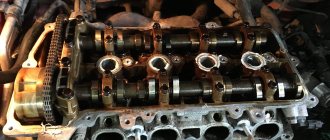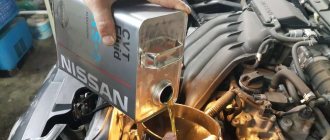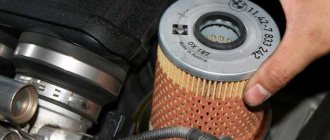Changing the oil in a Honda SRV automatic transmission is one of those mandatory procedures, without which the car is subject to rapid wear. Despite the fact that the Honda CR-V is positioned as a reliable budget crossover with the makings of an SUV, its units do not last forever and require constant attention from the owner. And the automatic transmission is the most capricious mechanism in a car.
Transmission oil change interval
Most often, Russian car enthusiasts are faced with the procedure for changing the oil in an MR4A automatic transmission on a Honda SRV 3 car. This modification, produced between 2007 and 2011, has won recognition among many compatriots. Even a high-quality original “transmission” with mileage loses its working properties and no longer copes with its tasks.
Over time, the automatic transmission of a Honda crossover begins to behave capriciously and this manifests itself in the form of symptoms:
- over-throttle during gear changes;
- jolts when the accelerator pedal is depressed;
- slipping during start;
- tightening with changing speed.
Experts recommend not to wait for failures in the operation of the unit, but to change the oil in the 3rd generation Honda SRV automatic transmission with a mileage of 30 - 40 thousand kilometers.
This interval also applies to other modifications of the model. For those who are used to driving a car at high speeds or loading the transmission off-road, the fluid should be changed more often.
Read
Changing the oil and filter in the Subaru Forester automatic transmission
When do you need to change the oil in a Honda SRV gearbox?
Starting with the first generation SRV models, Honda transmissions included an automatic transmission option. At first these were four-speed gearboxes, then five-speed automatic transmissions appeared on some second-generation crossovers. On the third and fourth car models, automatic transmissions are only 5-speed. In total, more than 10 modifications of automatic transmissions were created for SRV. However, they are all similar in design and practically identical in maintenance. The specificity of Honda automatic transmissions is that they differ in the design of the mechanical part from most types of automatic transmissions from other manufacturers. Usually behind the torque converter in an automatic transmission there are mechanics built on planetary gearboxes.
Honda went its own way and used a multi-shaft gearbox, similar to conventional manual gearboxes. Each pair of gears on the shafts implements one of the gearbox stages and is connected by an individual “wet” type multi-disc clutch, which is lubricated under pressure with transmission fluid. The clutch discs of the gears not currently engaged rotate freely relative to each other. The distance between them does not exceed 0.1 mm. Lubricant supplied under pressure ensures easy slipping of the discs. Therefore, the requirements for cleanliness and pressure of transmission fluid in Honda SRV boxes are high. When the transmission fluid filtration system becomes clogged, increased wear of the clutches occurs, resulting in a reduction in the service life of the entire automatic transmission.
The box contains 2 filters, one for coarse cleaning. It is located inside the automatic transmission; it can only be replaced by disassembling the box. The fine filter, “pass-through”, is located outside the machine body and is periodically replaced.
This design of the Honda SRV automatic transmission dictates that the working fluid be replaced every 45 thousand kilometers. The fine filter should be changed at least once every 90 thousand km. But some owners combine filter and oil changes every 45 thousand km.
Such a careful approach to technology is not in vain. On one of the specialized Honda forums, the appearance of a first-generation crossover with a mileage of about 700 thousand km without major overhaul of the power unit was recorded.
Practical advice on choosing oil in an automatic transmission Honda CR-V
A design feature of the automatic transmission on a Honda is a non-removable pan. For this reason, hardware replacement of the transmission is prohibited, since when exposed to high pressure, all deposits in the pan will clog the filter or get into the narrow channels of the valve body. Such a procedure can be disastrous for the Honda SRV gearbox.
Taking into account the complexity of 100% updating of the “transmission” on different modifications (RD1, RD4, RE, etc.), the question arises - what kind of oil should be poured into the automatic transmission of a Honda SRV station wagon in order to maximize the service life of the unit. The manufacturer of the Japanese crossover recommends using only the original product, which was originally filled at the factory.
Experienced car enthusiasts claim that the use of ATF (automatic transmission fluid) with the same characteristics as the original will not harm the automatic transmission. Analogs are produced under strict quality control. The use of such a product does not affect the performance of the Honda automatic transmission and the smoothness of gear shifting.
Analogs
Automatic transmission oil for Honda SRV 3 and any other generation can be purchased cheaper by choosing its analogue. Among the most popular brands are several:
| Transmission fluid name | Article (code) | Average price for 1l (4 l), rub |
| Idemitsu ATF DW-1 | 304502447460E0020 | (2000) |
| Patron ATF DW-1 | ATFMULTIVEHICLE1LORIGINAL | 525 |
| Petronas Tutela GI/E | 15051616 | 630 |
| Castrol ATF Multivehicle | 154F32 | 730 |
| Ravenol ATF Type Z1 Fluid | 1211109-004-01-999 | (3350) |
| Redline D4 ATF | 30504 | 1400 |
All these analogues have proven themselves to be a quality product that does not negatively affect the box of the Japanese station wagon. Such a wide selection of high-quality automatic transmission oils for the Honda CR V is due to the high popularity of this car, which in 2008 took first place in sales in Europe.
Read
What are automatic transmission clutches and how to replace them yourself
Original oil
Initially, the original oil, which was poured into automatic transmissions at the factory on all Honda SRVs up to and including the 3rd generation, was called ATF Z1. Its article number is 08266-999-01HE for a liter bottle and 08266-999-04HE for a 4-liter canister, produced under the Honda brand in Japan. Since 2011, manufacturers of Japanese Honda cars began to use synthetic fluid ATF DW 1 instead of mineral water with article numbers 08268-999-01HE and 08268-999-04HE, respectively. But even on a 2008 Honda CR V, you can fill the automatic transmission with a new generation of oil without fear of mixing it with another. These fluids are interchangeable.
To purchase a real ATF from the Japanese manufacturer Honda, you must carefully check the article number when ordering and make purchases from trusted dealers. You can stumble upon a fake at street markets or by ordering goods on unknown sites, tempted by a reduced price. The original product ATF Z1 or ATF DW1 should cost at least 900 rubles for a liter canister, and at least 3,500 rubles for a 4-liter container.
Another Honda Ultra ATF DW1 fluid with catalog number 08266-99964 is also a Honda product with more advanced properties. Its average price is 4,700 for a 4-liter canister.
Should I wash the box?
Definitely worth it. Over time, the oil loses its lubricating properties and is no longer able to cool the internal components of the gearbox, which as a result overheat and wear out quickly. At the same time, dirt deposits and metal shavings accumulate inside the box - a consequence of mechanical wear of parts.
Please note that some Honda CR-V configurations are not equipped with a removable pan, so a lot of dirt quickly accumulates in the gearbox. All this dirt also clogs the oil filter, which also has to be changed.
If you do not pay attention to these problems for a long time, sooner or later the gearbox will become unusable. Even the dealership may refuse to undertake transmission repairs and will advise you to replace the transmission with a new one. Therefore, you need to check and change the oil regularly, at least every 20 thousand km.
Checking the level
Before starting the procedure with changing ATP, it is necessary to measure its level in the automatic transmission. To do this, you need to select a flat area and turn off the engine. You will need to open the hood and find the transmission dipstick. It is located between the battery and the air filter.
Pull out the dipstick, wipe it dry with a rag or sponge, and insert it back again. And after that, look at the level. On the dipstick itself there is a mark with the inscription “MAX”; the liquid should be at this mark or slightly lower. After replacing the transmission, the level should remain the same.
Read
Do-it-yourself complete and partial oil change in automatic transmission Suzuki SX4
Materials for a comprehensive oil change in an automatic transmission Honda CR-V
During a comprehensive replacement of ATF in the automatic transmission of a Honda SRV 3 station wagon and other generations, it is necessary to change the external oil filter, in which various contaminants settle.
For the entire procedure you will need:
- jack or trestle;
- transmission fluid (4 liters for partial, 8 liters for complete replacement);
- external automatic transmission oil filter (original article number 25430-PLR-003);
- sealing washer 18 mm;
- empty containers with a volume of at least 4 liters (additionally 1.5 or 2 liters in case of complete replacement);
- a funnel and a thin rubber hose for filling in new ATP;
- set of tools;
- clean rags.
A car enthusiast who independently decides to change the ATF in a Honda automatic transmission should wear a special overall or thick work clothes so that if hot liquid gets on the body, he will not get burned.
Do-it-yourself automatic transmission oil change in Honda CR-V
Changing the oil in Honda SRV automatic transmissions from 1st to 4th generations follows one algorithm. The only difference is the working volume of the unit, which determines how much ATP will spill out and how much needs to be poured back. During automatic transmission maintenance on a Honda SRV 2, about 3.1 liters of oil must be replaced, and on other generations this volume averages 3.5 liters.
Draining old oil from the tank
To drain the automatic transmission oil on Honda SRV RD1 and subsequent generations, you need to turn the wheels to the right. This will allow you to get to the drain plug. For greater efficiency, it is better to raise the left side of the car. At the level of the drain hole, first place a wide container such as a basin or a 5-liter canister with a cut off neck.
Read
All diseases of the Citroen C4 automatic transmission and their repair
If there is engine protection, it must be removed. To the right of the Honda engine, near the wheel, there is an automatic transmission pan and a drain plug. It needs to be cleaned of dirt so that it can then be unscrewed using a tetrahedron. You need to unscrew it carefully and quickly, trying not to get burned by the leaking hot liquid. The volume of the drained “transmission” must be measured.
Washing the tray and removing chips
On the inside of the drain plug there is a special magnet that attracts metal shavings formed in the Honda automatic transmission during friction of the mechanisms. It must be removed with a clean cloth and wiped dry. When installing the plug back, you should install a new O-ring.
The standard procedure for flushing the pan on a Honda SRV automatic transmission cannot be carried out. The pan on the Japanese station wagon is not removable. Complete disassembly of the unit can only be organized at a service station.
Replacing the filter
According to the regulations, the automatic transmission filter on a Honda SRV must be replaced every 90 thousand kilometers. If the car was purchased secondhand, it is recommended to carry out comprehensive automatic transmission maintenance, regardless of mileage. You can get to the external filter from the hood side by first removing the air filter.
The Honda filter itself is screwed on with a clamp, which can be removed using a 10mm wrench. Two tubes go to the filter device on opposite sides. They must be removed carefully, as a small amount of ATP will flow from them. Now you can replace the filter and perform all the steps in reverse order.
Filling with new oil
To fill in fresh oil for a Honda SRV automatic transmission, you need to complete 3 mandatory procedures:
- measure the required amount of transmission fluid equal to the drained volume;
- install a narrow hose into the hole for the dipstick, insert a funnel into the hose and secure it at a low height;
- slowly pour ATP through the funnel into the automatic transmission hole.
Read
Checking the level and changing the oil in the Mazda CX-5 automatic transmission yourself
It is advisable to use an original product under the Honda ATF DW1 brand as a liquid, or find an analogue with the same characteristics.
Choosing oil for Honda CRV
The choice of oil for Honda CRV automatic transmission is made in accordance with the manufacturer’s recommendations. Experts note that only ATF DW1 . This generation replaced the ATF Z1 and is considered the only quality choice for the presented car models.
The choice is due to the fact that other brands of lubricant cannot withstand the operating temperature of the transmission, which leads to their boiling and rapid failure of the automatic transmission. According to Honda car manufacturers, the gearbox in this case will have to be changed after 30-40 thousand kilometers.
Complete replacement of transmission fluid in automatic transmission
If the car was purchased at a dealership and was operated by one owner, there should be no problems with the gearbox. For preventive purposes, a partial renewal of ATP is sufficient. A complete oil change in a Honda automatic transmission is required if the car was purchased second-hand or was operated with frequent overloads of the units. It is carried out in two ways:
- Repeat partial replacement 3-4 times at weekly intervals. Each time the liquid is renewed by a larger percentage of the total volume.
- Carry out a complete update by running fluid through the radiator. To do this, you need to remove the hose coming from the radiator from the Honda automatic transmission pipe. Place its end into a small transparent container (1.5 - 2 liters). Then start the engine for 10-15 seconds. At this time, an assistant must monitor the level of liquid drained into the bottle so that there is no overflow. The engine is turned off, the volume of drained ATP is measured and exactly the same amount of fresh ATP is poured back into the automatic transmission. The procedure is repeated until the color and transparency of the leaking oil matches the new one.
Automatic transmission oil
Note
: – There are two types of oil changes in an automatic transmission: partial and complete. During a partial replacement, approximately half of the total oil volume is changed, since it is impossible to drain all the oil; it remains in the torque converter, as well as in some other components of the system. To make a complete replacement, you need special equipment to pump out all the transmission oil from the system. Then the system is flushed and new oil is added. It is advisable to carry out a complete replacement at a specialized car service center. – With a partial replacement, the volume of oil to be filled is approximately 2.6 liters. – Recommended oil: Honda ATF DW-1.
Attention
: The use of oil other than Honda ATF DW-1 may cause serious deterioration in the performance of the automatic transmission, significantly reduce its service life, and also cause transmission malfunction.
1. If the gearbox is cold, start and warm up the engine to normal operating temperature (the electric fan of the cooling system should turn on) so that the gear oil has sufficient fluidity.
2. Place the car over a hole or overpass, or slightly lift the front of the car so that you can get to the drain plug (to do this, first apply the parking brake to the car and install wheel chocks under the rear wheels).
3. Turn off the engine and wait a few minutes for the oil to completely drain into the gearbox.
5. Slightly lift the automatic transmission oil dipstick.
Attention
: Next, be careful not to touch the hot elements of the exhaust system.
6. We climb under the car and use a Phillips screwdriver to unscrew the two screws securing the plastic hatch in the lower engine protection.











